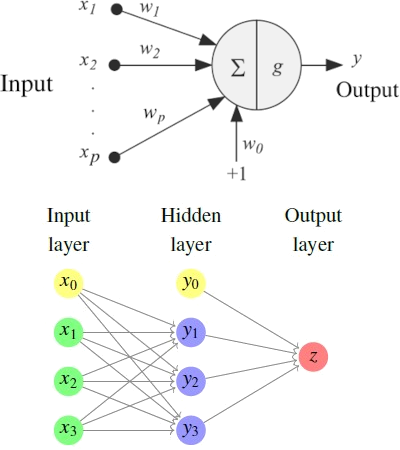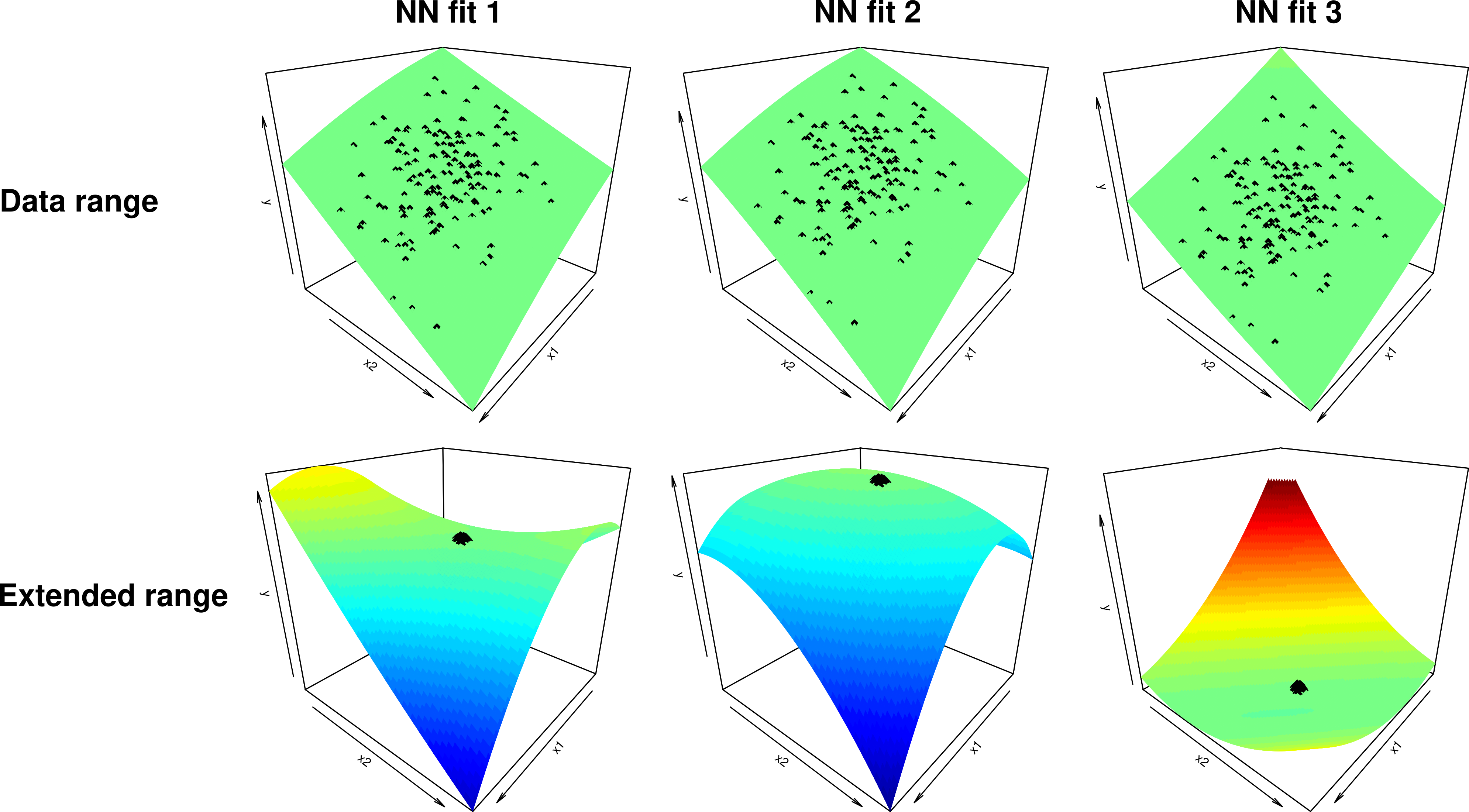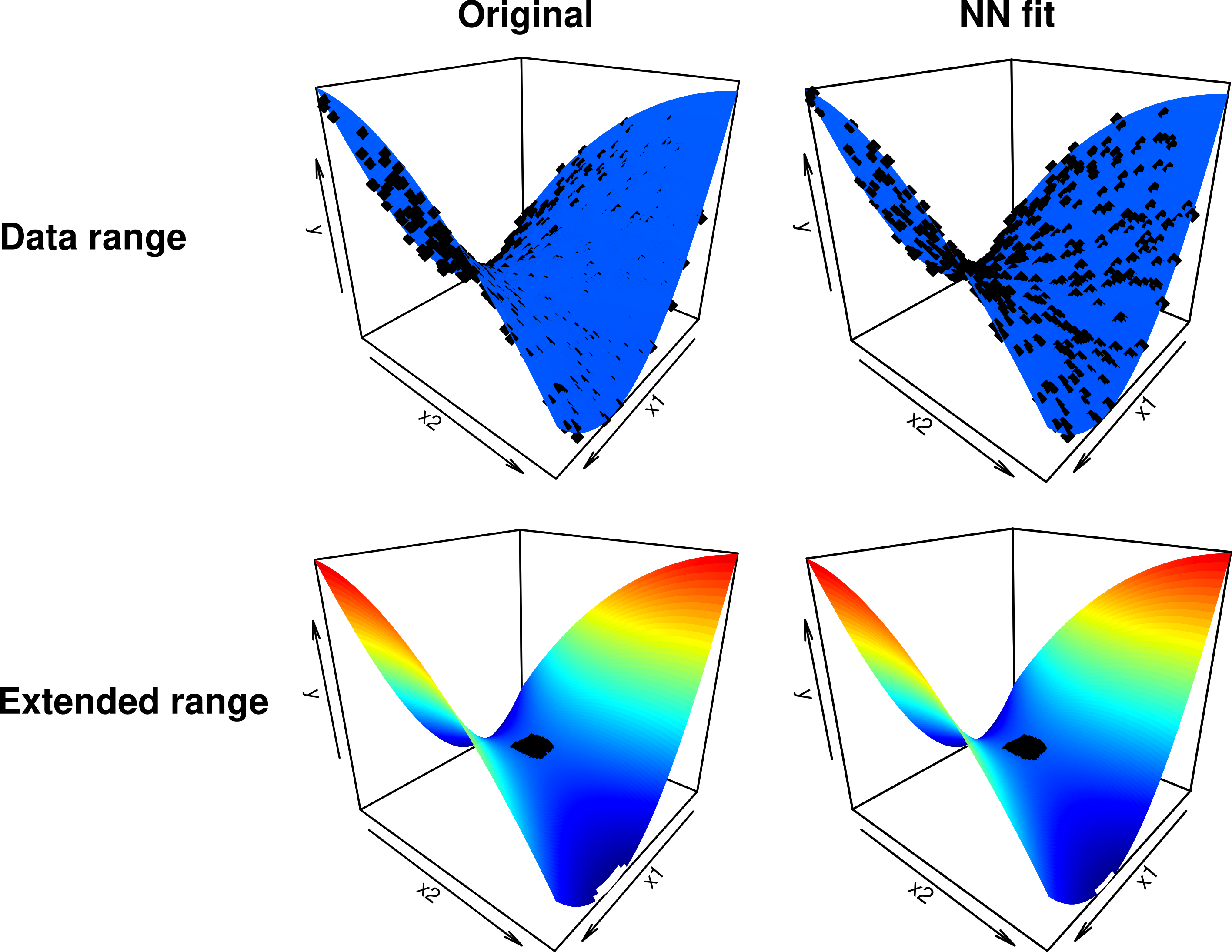class: center, middle, inverse, title-slide .title[ # Opening the black box ] .subtitle[ ## From Neural Nets to Polynomials and beyond ] .author[ ### <strong>Iñaki Úcar</strong> | Postdoctoral Fellow @ IBiDat ] .date[ ### June 2, 2022 ] --- # Context -- .research-left-column[ ## Statistical software - **R project** contributor since 2015 - 9 packages on CRAN - Maintainer of **r-simmer** DES - Published in the JSS - Co-maintainer of **r-quantities** - Published in the R Journal - Funded by the R-Consortium - Member of the **Rcpp Core** team - Co-founder of **ROpenSpain** ]  -- .research-right-column[ ## Social applications - Socioeconomic status - Inequality - Mobility - ... #### Projects: - **CONCIERGE-CM-UC3M** (co-PI) - with Marga Torre <br>Dept. Social Sciences, UC3M - **StatPhys4Cities** - with Esteban Moro <br>Dept. Mathematics, UC3M <br>MIT Media Lab ] -- .research-overlay[.research-center-column[ ## Interpretability of NN - From business needs - Started as exploratory TFMs - then Pablo Morala's thesis <br>co-supervision - Rosa E. Lillo - J. Alexandra Cifuentes #### Outline: - Initial work (paper) - [10.1016/j.neunet.2021.04.036](https://doi.org/10.1016/j.neunet.2021.04.036) - Current status (preprint) - [10.48550/arXiv.2112.11397](https://doi.org/10.48550/arXiv.2112.11397) - Open challenges, vision, impact ]] --- class: inverse, center, middle # Interpretability of .emph[Neural Networks] via .emph[Polynomials] --- class: base24 # Introduction .left-column[ ### Motivation ] .right-column[ Machine learning (ML) is a **growing trend** in many organisations<br> Neural Networks (NNs) and Deep Learning (DL) are achieving a great success ] -- .right-column-append[ **Drivers:** - Big Data (both structured and non-structured) - Cloud Computing - Prediction performance ] -- .right-column-append[ **Blockers:** - Fairness - Explainability, interpretability - Regulations ] --- class: base24 # Introduction .left-column[ ### Motivation ### Seminal paper ] .right-column[  > Cheng, X., Khomtchouk, B., Matloff, N., Mohanty, P. (2019). > _Polynomial Regression As an Alternative to Neural Nets._ > _arXiv_ [cs.LG, stat.ML]. > DOI: [10.48550/arXiv.1806.06850](https://doi.org/10.48550/arXiv.1806.06850) Presents the following ideas: - NNs.emph[*] are a form of Polynomial Regression (PR). - The **degree** of the polynomial increases with each hidden layer. - PR properties can be used to study and even **solve NN problems**. - **Experimental results**: PR as good as NNs in the studied datasets. - Using PR instead of NNs: **R package {polyreg}**. .footnote[.emph[*] Specifically, fully-connected feed-forward NN, AKA multilayer perceptrons (MLPs).] ] --- class: base24 # Introduction .left-column[ ### Motivation ### Seminal paper ### Main idea ] .right-column[ **Transform a trained NN into an .emph[equivalent] polynomial** .pull-left[ Objectives: - Explicit model - Reduced number of parameters - Interpretability of coefficients - ... - Study NN properties - Inform NN dimensioning - ... ] .pull-right[  ] ] --- class: base24 # Framework .left-column[ ### Initial work ] .right-column[  > Morala, P., Cifuentes, J. A., Lillo, R. E., **Ucar, I.** (2021a). > _Towards a framework to inform neural network modelling via polynomial regression._ > _Neural Networks_, 142, 57–72. > DOI: [10.1016/j.neunet.2021.04.036](https://doi.org/10.1016/j.neunet.2021.04.036) Main merits: - Find an **explicit expression** to build a polynomial from the .emph[weights] of a trained MLP, using a .emph[Taylor expansion] of the activation function - Limited to a single hidden layer and linear output - Weights need to be constrained for the expansion to remain valid - Validated through a **simulation study** ] --- class: base24 # Framework .left-column[ ### Initial work ### Notation ] .right-column[ Polynomial of degree `\(k\)` in `\(p\)` variables: `$$z = \beta_{0} + \underbrace{\beta_{1} x_{1} + \dots + \beta_{p}x_{p}}_{1\mbox{-order interactions}} +\dots + \underbrace{\beta_{1 p\dots p}x_1x_p^{k-1} + \dots + \beta_{p\dots p}x_p^{k}}_{k\mbox{-order interactions}}$$` ] -- .right-column-append[ .pull-left[ Hidden layer, neuron `\(j\)`: `$$y_j = g(u_j) = g\left(\sum_{i=0}^p w_{ij} x_{i} \right)$$` Final output: `$$z=\sum_{j=0}^{h_1} v_{j} y_{j} = \sum_{j=0}^{h_1} v_{j} g\left(\sum_{i=0}^p w_{ij} x_{i} \right)$$` ] .pull-right[  ] ] --- class: base24 # Framework .left-column[ ### Initial work ### Notation ### Tools ] .right-column[ Taylor expansion of the activation function `\(g\)`: `$$y_j=g\left(\sum_{i=0}^pw_{ij}x_i\right)=\sum_{n=0}^{\infty}\frac{g^{(n)}(a)}{n!}{\color{blue}\left(\sum_{i=0}^pw_{ij}x_i-a\right)^n}$$` Binomial theorem: `$${\color{blue}\left(\sum_{i=0}^p w_{ij}x_{i}-a\right)^n} = \sum_{k=0}^n \binom{n}{k}(-a)^{n-k}{\color{magenta}\left(\sum_{i=0}^pw_{ij}x_i\right)^k}$$` Multinomial theorem: `$${\color{magenta}\left(\sum_{i=0}^p w_{ij}x_{i}\right)^k} = \sum_{m_{0}+\cdots+m_{p}=k}{\binom{k}{m_{0}, \dots, m_{p}}} (w_{0j}x_{0})^{m_{0}} \cdots (w_{pj}x_{p})^{m_{p}}$$` ] --- class: base24 # Framework .left-column[ ### Initial work ### Notation ### Tools ### Coefficients ] .right-column[ Output expanded at `\(a=0\)`, truncated at degree `\(q\)`: `$$z\approx v_0+\sum_{j=1}^{h_1}v_j\sum_{n=0}^{q}\dfrac{g^{(n)}(0)}{n!}\left[\sum_{m_{0}+\cdots+m_{p}=n}{\binom{n}{m_{0}, \dots, m_{p}}} (w_{0j}x_{0})^{m_{0}} \cdots (w_{pj}x_{p})^{m_{p}}\right]$$` **Intercept:** `$$\beta_0=v_0+\sum_{j=1}^{h_1}v_j\left(\sum_{n=0}^{q}\frac{g^{(n)}(0)}{n!}w_{0j}^{n}\right)$$` **Interactions of order `\(T\)`:** `$$\beta_{t_1t_2\dots t_T}=\sum_{j=1}^{h_1}v_j\left(\sum_{n=T}^{q}\frac{g^{(n)}(0)}{(n-T)!\cdot m_1!\cdots m_p!} w_{0j}^{n-T}w_{1j}^{m_1}\dots w_{pj}^{m_p}\right)$$` ] --- class: base24 # Framework .left-column[ ### Initial work ### Notation ### Tools ### Coefficients ### `\(g\)` expansion ] .right-column[ .pull-left-mod[ Example: **softplus** `$$g(x)=\ln\left(1+e^x\right)$$` <br><br><br><br>Legend: - Real function - .red[Taylor expansion], order `\(q\)` - .blue[Error] (difference) ] .pull-right-mod[  ] ] --- class: base24 # Simulation study .left-column[ ### Procedure ] .right-column[  ] --- class: base24 # Simulation study .left-column[ ### Procedure ### Results I ] .right-column[ .pull-left-mod[ (1) Good case<br> (2) Bad case <br><br><br><br><br><br> (A) Response vs. Predicted NN<br> (B) Predicted NN vs. Polynomial<br> (C) Expansion validity region + <br>  dist. of activations `\(u_j\)` ] .pull-right-mod[  ] ] --- class: base24 # Simulation study .left-column[ ### Procedure ### Results I ### Performance I ] .right-column[ .pull-left-mod[ - 500 MSE simulations - Data scaled to `\([-1, 1]\)` ] .pull-right-mod[  ] ] --- class: base24 # Simulation study .left-column[ ### Procedure ### Results I ### Performance I ### Surfaces I ] .right-column[  ] --- class: base24 # Framework .left-column[ ### Initial work ### Notation ### Tools ### Coefficients ### `\(g\)` expansion ### Constraints ] .right-column[ **Limited region** where Taylor expansion is accurate ] -- .right-column-append[ - Impose an `\(\ell_1\)`-norm equal to one for the hidden layer weights: `$$\left\lvert \left\lvert \vec{w}_{j} \right\rvert \right\rvert_1 = \sum_{i=0}^p \left\lvert w_{ij} \right\rvert = 1$$` - Then the **activations `\(u_j\)` are also constrained** by 1 in absolute value: `$$\lvert u_j \rvert = \left\lvert \sum_{i=0}^p w_{ij} x_{i} \right\rvert \leq \sum_{i=0}^p \left\lvert w_{ij} x_{i} \right\rvert \leq \sum_{i=0}^p \left\lvert w_{ij} \right\rvert = \left\lvert \left\lvert \vec{w}_{j} \right\rvert \right\rvert_1 = 1,$$` where `\(\left\lvert x_i\right\rvert \leq 1\)` because of the `\([-1,1]\)` scaling. Therefore, `\(\left\lvert u_j\right\rvert \leq 1\)` ] --- class: base24 # Simulation study .left-column[ ### Procedure ### Results I ### Performance I ### Surfaces I ### Results II ] .right-column[  ] --- class: base24 # Simulation study .left-column[ ### Procedure ### Results I ### Performance I ### Surfaces I ### Results II ### Performance II ] .right-column[  ] --- class: base24 # Simulation study .left-column[ ### Procedure ### Results I ### Performance I ### Surfaces I ### Results II ### Performance II ### Surfaces II ] .right-column[  ] --- class: base24 # Framework .left-column[ ### Current status ] .right-column[  > Morala, P., Cifuentes, J. A., Lillo, R. E., **Ucar, I.** (2021b). > _NN2Poly: A polynomial representation for deep feed-forward artificial neural networks._ > _arXiv_ [stat.ML, cs.LG]. > DOI: [10.48550/arXiv.2112.11397](https://doi.org/10.48550/arXiv.2112.11397) Main merits: - **Extend** previous work to MLPs with an .emph[arbitrary number] of hidden layers - **Extend** previous work to classification problems Underway: - Improve notation - Model the error ] --- class: base24 # Framework .left-column[ ### Current status ### Notation ] .right-column[ Consider a MLP with `\(L-1\)` hidden layers (0: input; `\(L\)`: output) Output at layer `\(l\)`, neuron `\(j\)`: `$$\prescript{(l)}{}{y}_j = \prescript{(l)}{}{g}\left(\prescript{(l)}{}{u}_j\right) = \prescript{(l)}{}{g}\left(\sum_{i=0}^{h_{l-1}}\prescript{(l)}{}{w}_{ij}\prescript{(l)}{}{x}_i\right)$$` Polynomial at layer `\(l\)`, neuron `\(j\)` of order `\(Q_{l-1}\)` in `\(p\)` variables: `$$\prescript{(l)}{}{P}_j\left(p,Q_{l-1}\right) = \sum_{\vec{t} \in \mathcal{T}(p,Q_{l-1})} \prescript{(l)}{}{B}_{j,\vec{t}}$$` where `\(B_{\vec{t}} = \beta_{\vec{t}} \cdot x_{t_1}\dots x_{t_T}\)` and `\(\mathcal{T}(p,Q_{l-1})\)` is the set of all possible interactions ] --- class: base24 # Framework .left-column[ ### Current status ### Notation ### Algorithm ] .right-column[ Using the first contribution, obtain the activation `\(\prescript{(2)}{}{u}_j \approx \prescript{(2)}{\mathrm{in}}{P}_j\left(p,Q_{1}\right)\)` ] -- .right-column-append[ For `\(l=2\dots L-1\)`: - Apply the Taylor expansion of the non-linearity `\(\prescript{(l)}{}{g}\)`: `$$\prescript{(l)}{}{y}_j \approx \prescript{(l)}{}{g}\left(\prescript{(l)}{}{u}_j\right) \approx \prescript{(l)}{\mathrm{out}}{P}_j\left(p,Q_{l}\right)$$` ] -- .right-column-append[ - Obtain the activation `\(\prescript{(l+1)}{}{u}_j\)` for each neuron `\(j\)` at layer `\(l+1\)`: `$$\prescript{(l+1)}{}{u}_j \approx \prescript{(l+1)}{\mathrm{in}}{P}_j\left(p,Q_{l}\right)$$` ] -- .right-column-append[ If it's a classification problem, apply the expansion of the non-linearity `\(\prescript{(L)}{}{g}\)` ] --- class: base24 # Framework .left-column[ ### Current status ### Notation ### Algorithm ### Coefficients ] .right-column[ **Interactions** at layer `\(l\)`, neuron `\(j\)` after including `\(\prescript{(l)}{}{g}\)` effect: `$$\prescript{(l)}{\mathrm{out}}{{\beta}}_{j,\vec{t}} = \sum_{n=0}^{q_{l}}\dfrac{\prescript{(l)}{}{g}^{(n)}(0)}{n!} \sum_{ \vec{m} \in \pi(\vec{t},l,n)} \left(\begin{array}{c} n \\ \vec{m}_{p,Q_{l-1}} \end{array}\right)\prod_{k=1}^{M_{p,Q_{l-1}}} \prescript{(l)}{\mathrm{in}}{\beta}_{j,k}^{m_{k}}$$` where `\(\pi(\vec{t},l,n)\)` is .emph[the set of all possible partitions] for a given combination of variables `\(\vec{t}\)`, layer `\(l\)` and order `\(n\)` **Interactions** for the linear case at layer `\(l+1\)`, neuron `\(j\)`:<br> (e.g., when `\(l+1=L\)` for the only output neuron in regression problems) `$$\prescript{(l+1)}{\mathrm{in}}{\beta}_{j,\vec{t}} = \sum_{i=0}^{h_{l}}\prescript{(l+1)}{}{w}_{ij} \cdot \prescript{(l)}{\mathrm{out}}{\beta}_{i,\vec{t}}$$` ] --- class: base24 # Simulation study .left-column[ ### Procedure ### Results I ### Performance I ### Surfaces I ### Results II ### Performance II ### Surfaces II ### Results III ] .right-column[ Example with **several layers**: - Output polynomial matches NN predictions - The distribution of activations `\(\prescript{(l)}{}{u}_j\)` is constrained at every hidden layer .pull-left[  ] .pull-right[  ] ] --- class: base24 # Summary .left-column[ ### Conclusions ] .right-column[ **Main contribution**: An .emph[explicit formula] to obtain an .emph[equivalent] polynomial from the weights of a trained MLP - The polynomial predicts as well (or as bad) as the NN - **Main advantage**: .emph[interactions] vs. simple feature importance ] -- .right-column-append[ The method provides polynomials **at each layer and neuron**, so it can be used to represent parts of a network by taking only the weights of a section and treating them like a smaller new NN ] -- .right-column-append[ This framework can be used to **interpret** NNs predictions, **study** their properties and explore how to **tune** their hyperparameters - And much more, e.g. explore how the training evolves ] --- class: base24 # Summary .left-column[ ### Conclusions ### Open challenges ] .right-column[ **Computationally expensive** combinatorial problem - Equivalent to finding the partitions of the multiset `\(\vec t\)` - Only one algorithm, by none other than... .emph[Donald Knuth]! in the 1980s ] -- .right-column-append[ Explicit formula for the **error**, CIs for the coefficients ] -- .right-column-append[ Applications to **real datasets** - Is the polynomial representation unique? ] -- .right-column-append[ Extensions to **other architectures** and non-tabular data ] --- class: inverse, center, middle # Wrap-up --- # Vision and impact .research-center-column[ ## Interpretability of NN - **NN2Poly** framework - Error estimation - Inform NN design - Sensitivity analysis - Extensions to other architectures - ... ]   -- .research-left-column[ ## Statistical software - Computational issues - Software packages ] ![:arrow left, 430px, 400px]()  -- .research-right-column[ ## Social applications - **StatPhys4Cities** - interpretable mobility models - ... ] ![:arrow right, 849px, 400px]()  --- class: inverse, center, middle # Thanks! Questions? Slides created via the R package [**xaringan**](https://github.com/yihui/xaringan). The chakra comes from [remark.js](https://remarkjs.com), [**knitr**](https://yihui.org/knitr/), and [R Markdown](https://rmarkdown.rstudio.com). --- class: base24 # Appendix .left-column[ ### Combinatorial problem ] .right-column[ The original variables `\(x_i\)` are included in the terms `\(\prescript{(l)}{}{B}_{j,\vec{t}}\)`, and will depend on the exponents `\(m_k\)` For a given coefficient `\(\prescript{(l)}{\mathrm{out}}{{\beta}}_{j,\vec{t}}\)`, all the products of terms `\(\prescript{(l)}{\mathrm{in}}{B}_{j,\vec{t}}\)`, that would yield the combination of variables determined by `\(\vec{t}\)`, need to be considered Example: consider `\(\prescript{(l)}{\mathrm{out}}{{\beta}}_{j,(1,1,2,3)}\)`, associated to `\(x_1^2x_2x_3\)`. This is included in the term `\(\prescript{(l)}{\mathrm{in}}{B}_{j,(1,1,2,3)}\)`, but also in the product of terms `\(\prescript{(l)}{\mathrm{in}}{B}_{j,(1,1)}\prescript{(l)}{a}{B}_{j,(2,3)}\)` or in the product of the four terms `\(\prescript{(l)}{\mathrm{in}}{B}_{j,(1)}^2 \prescript{(l)}{\mathrm{in}}{B}_{j,(2)} \prescript{(l)}{\mathrm{in}}{B}_{j,(3)}\)` ] --- class: base24 # Appendix .left-column[ ### Combinatorial problem ### Multiset partitions ] .right-column[ Equivalent to finding all the possible partitions of the multiset `\(\vec t\)` E.g., for `\(\{1,1,2,3\}\)`, these are: `$$\begin{matrix}\{1,1,2,3\} & \{1,1\},\{2,3\} & \{1\},\{3\},\{1,2\} \\ \{1\},\{1,2,3\} & \{1,2\},\{1,3\} & \{2\},\{3\},\{1,1\} \\ \{2\},\{1,1,3\} & \{1\},\{1\},\{2,3\} & \{1\},\{1\},\{2\},\{3\} \\ \{3\},\{1,1,2\} & \{1\},\{2\},\{1,3\} & \end{matrix}$$` Some restrictions apply to these partitions, as their size is limited by `\(q_l\)` and the order of their elements is limited by `\(Q_{l-1}\)` ]